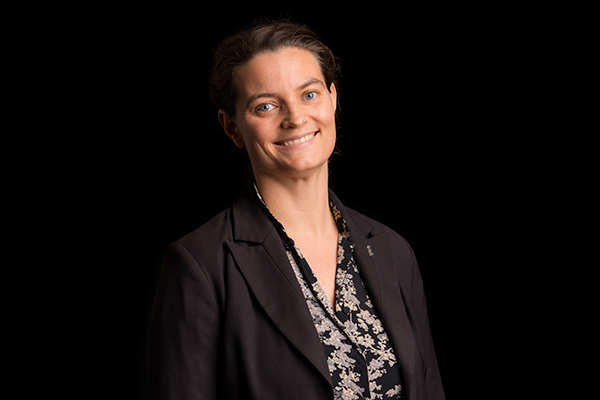Sofie Laurine Albris
Research leader

Project title
FORTIS: Fortified Island. Militarisation, Conflict and Communities on Iron Age Bornholm
What is your project about?
The FORTIS project is about militarisation and society on Bornholm in the Iron Age (the period ca. AD 1 - 1050). The project focuses on Bornholm's Iron Age fortifications and their social context. The construction of defence works required extensive resources and was an important part of the ways the islanders dealt with conflicts, threats and attacks. The goals of the project are to gain better insight into the construction and dating of the individual forts, and further to understand them in relation to the general organisation of society and military on Bornholm - and in relation to developments in the Baltic Sea, Scandinavia and Northern Europe. The project is carried out in three parallel thematic strands, where the first consists of mapping, surveying and excavating the individual fortifications and their surroundings. In addition, the organisation of the general settlement and agricultural landscape is described and analysed in relation to the forts. Further, the project explores the military and social organisation as reflected in the island's weapon burials and their relations in time and space.
How did you become interested in your particular field of research?
I have always been fascinated by the Iron Age, especially the period from the century before our era to the 10th century, because the historical and cultural developments in Europe of this time have been determining for the way our world is shaped today. My interest in this period arose already in my childhood, when I became a real bookworm and delved into in Norse and Greek mythology. I found archaeology in Skalk-magazines in my grandmother's attic. During my student years, I wandered between various disciplines as approaches to the Iron Age. I ended up working in a cross-field between archaeology and onomastics, which gives me insights into different angles on humans and mentality in the past. My previous research project on Iron Age personal names sparked an interest in the deep influence of military and warrior ideology on the Scandinavian Iron Age mindset.
What are the scientific challenges and perspectives in your project?
There are at least six Iron Age forts on Bornholm, but our knowledge about them and about their relations to the surroundings is diverse and generally lacking. Iron Age defence works (prior to Viking Age Trelleborg-fortifications) are a somewhat neglected source category in Danish archaeology, and we are lagging behind, for example, the Swedish Baltic island of Öland. The project will close a gap in our general knowledge about and understanding of conflicts and societies in the Baltic Sea region in the Iron Age. The challenge will be to raise our knowledge of Bornholm's defence systems to a level where it can be better compared with other parts of the Baltic Sea. It requires that the field work is well planned, to enable us to obtain as much relevant knowledge as possible. We know that the fortification sites were used in various time periods, such as the Stone Age, the Bronze Age and the Middle Ages, and we have an obligation to document everything, even though in this project we are specifically interested in the Iron Age.
What is your estimate of the impact, which your project may have to society in the long term?
The FORTIS project can contribute to creating more nuanced perceptions of tensions and conflicts in the Baltic Sea area and to a general insight into the way militarisation can shape societies. The project does this by focusing on the special historical qualities and security perspectives of Bornholm through the deep-time perspective. In the past, as today, Bornholm had a both central and exposed position in the Baltic Sea. In the Iron Age, the island was a natural hub for trade and connections, but precisely this favourable location meant that the island was threatened by looting and power struggles. We see a similar duality today, where Bornholm is both a favourite tourist destination and a military focus area. The project will also generate new knowledge about societal developments in the Iron Age, that are central to our understanding of early state formation and establishment of royal power in Southern Scandinavia.
Which impact do you expect the Sapere Aude programme will have on your career as a researcher?
The Sapere Aude grant means that I can make the important step from individual research to gaining experience in management of larger, more complex projects. The grant provides me with a platform to establish and position myself as a research leader. In addition, I will have the opportunity to build on the international networks I have formed during my previous grant period in Norway. It is absolutely essential that I am allowed to assemble a team of highly qualified researchers with different specialised skills, who together form an ideal starting point for exploring the effects of war and conflict on Bornholm's Iron Age society.
Background and personal life
After three years at the University of Bergen, my Norwegian husband and I have settled in Lejre in the middle of Zealand with our two children. In my spare time, I prefer to be outside in nature with my family. I used to have a lot of hobbies, such as drawing, painting, riding and reading fiction, but these are all neglected in a life with research and children. I do get to pursue my interests in cooking, a bit of running, yoga and sometimes sewing and crocheting. My husband and I share our interests in nature and prehistory, so this affects our family's spare time and the children get to see their share of stave churches and rune stones.
View all research leaders here
Research institution
National Museum of Denmark
Research field
Archaeology
City of your current residence
Lejre
High school
Aurehøj Gymnasium
